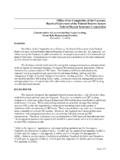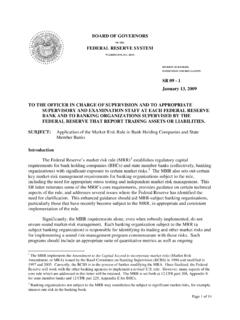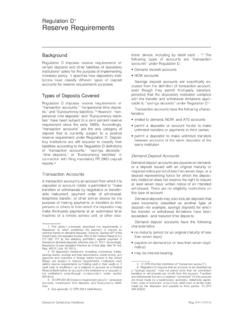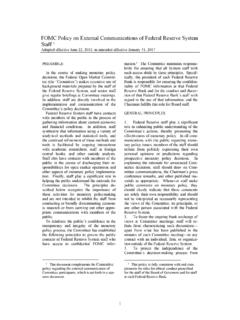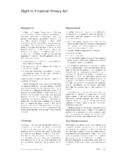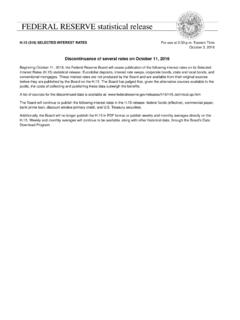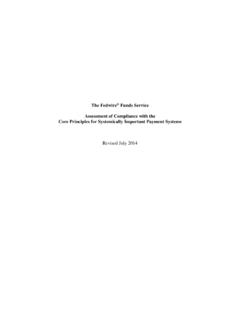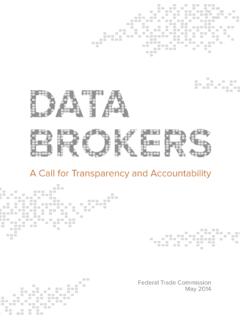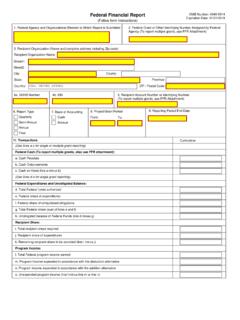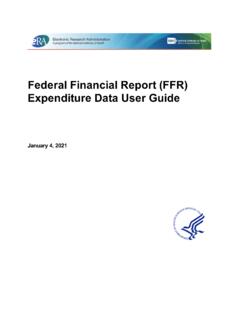Transcription of Financial Stability Report - federalreserve.gov
1 Financial Stability Report November 2021. B o a r d o f G o v e r n o r s o f t h e F e d e r a l R e s e rv e S y s t e m Financial Stability Report November 2021. B o a r d o f G o v e r n o r s o f t h e F e d e r a l R e s e rv e S y s t e m This and other federal Reserve Board reports and publications are available online at To order copies of federal Reserve Board publications offered in print, see the Board's Publication Order Form ( ). or contact: Publications Fulfillment Mail Stop N-127. Board of Governors of the federal Reserve System Washington, DC 20551. (ph) 202-452-3245. (fax) 202-728-5886. (email) iii Contents Purpose .. 1. Framework .. 3. Overview .. 7. 1. Asset Valuations .. 9. 2. Borrowing by Businesses and Households .. 27. 3. Leverage in the Financial Sector.
2 37. 4. Funding Risk .. 45. Near-Term Risks to the Financial System .. 59. Figure Notes .. 69. Boxes Retail Investors, Social Media, and Equity Trading .. 18. The Role of Foreign Investors in the March 2020 Turmoil in the Treasury Market .. 22. Liquidity Vulnerabilities from Noncash Collateral at Central Counterparties .. 51. LIBOR Transition Update .. 55. The Financial Stability Oversight Council's Climate Report and the federal Reserve's Actions .. 62. Cyber Risk and Financial Stability .. 64. Salient Shocks to Financial Stability Cited in Market Outreach .. 67. Note: This Report generally reflects information that was available as of October 25, 2021. 1. Purpose This Report presents the federal Reserve Board's current assessment of the resilience of the Financial system.
3 By publishing this Report , the Board intends to promote public under- standing and increase transparency and accountability for the federal Reserve's views on this topic. Promoting Financial Stability is a key element in meeting the federal Reserve's dual mandate for monetary policy regarding full employment and stable prices. In an unstable Financial system, adverse events are more likely to result in severe Financial stress and disrupt the flow of credit, leading to high unemployment and great Financial hardship. Monitoring and assessing Financial Stability also support the federal Reserve's regulatory and supervisory activities, which promote the safety and soundness of our nation's banks and other impor . tant Financial institutions. Information gathered while monitoring the Stability of the finan- cial system helps the federal Reserve develop its view of the salient risks to be included in the scenarios of the stress tests and its setting of the countercyclical capital buffer (CCyB).
4 1. The Board's Financial Stability Report is similar to those published by other central banks and complements the annual Report of the Financial Stability Oversight Council (FSOC), which is chaired by the Secretary of the Treasury and includes the federal Reserve Board Chair and other Financial regulators. 1. More information on the federal Reserve's supervisory and regulatory activities is available on the Board's website; see Board of Governors of the federal Reserve System (2021), Supervision and Regulation Report (Washington: Board of Governors, April), available at as well as the webpages for Supervision and Regulation ( ) and Payment Systems ( ). Moreover, additional details about the conduct of monetary policy are also on the Board's website; see the Monetary Policy Report ( ) and the webpage for Monetary Policy ( ).
5 3. Framework A stable Financial system, when hit by adverse events, or shocks, continues to meet the demands of households and businesses for Financial services, such as credit provision and payment services. By contrast, in an unstable system, these same shocks are likely to have much larger effects, disrupting the flow of credit and leading to declines in employment and economic activity. Consistent with this view of Financial Stability , the federal Reserve Board's monitoring framework distinguishes between shocks to and vulnerabilities of the Financial system. Shocks, such as sudden changes to Financial or economic conditions, are typically surprises and are inherently difficult to predict. Vulnerabilities tend to build up over time and are the aspects of the Financial system that are most expected to cause widespread problems in times of stress.
6 As a result, the framework focuses primarily on monitoring vulnerabilities and emphasizes four broad categories based on 1. Elevated valuation pressures are signaled by asset prices that are high relative to eco- nomic fundamentals or historical norms and are often driven by an increased willingness of investors to take on risk. As such, elevated valuation pressures imply a greater possibil- ity of outsized drops in asset prices. 2. Excessive borrowing by businesses and households leaves them vulnerable to distress if their incomes decline or the assets they own fall in value. In the event of such shocks, businesses and households with high debt burdens may need to cut back spending sharply, affecting the overall level of economic activity. Moreover, when businesses and households cannot make payments on their loans, Financial institutions and investors incur losses.
7 3. Excessive leverage within the Financial sector increases the risk that Financial institu- tions will not have the ability to absorb even modest losses when hit by adverse shocks. In those situations, institutions will be forced to cut back lending, sell their assets, or, in extreme cases, shut down. Such responses can substantially impair credit access for house- holds and businesses. 4. Funding risks expose the Financial system to the possibility that investors will run by withdrawing their funds from a particular institution or sector. Many Financial institu- tions raise funds from the public with a commitment to return their investors' money on short notice, but those institutions then invest much of the funds in illiquid assets that 2. For a review of the research literature in this area and further discussion, see Tobias Adrian, Daniel Covitz, and Nellie Liang (2015), Financial Stability Monitoring, Annual Review of Financial Economics, vol.
8 7 (December), pp. 357 95. 4 Framework are hard to sell quickly or in assets that have a long maturity. This liquidity and maturity transformation can create an incentive for investors to withdraw funds quickly in adverse situations. Facing a run, Financial institutions may need to sell assets quickly at fire sale prices, thereby incurring substantial losses and potentially even becoming insolvent. Histo rians and economists often refer to widespread investor runs as Financial panics.. These vulnerabilities often interact with each other. For example, elevated valuation pres- sures tend to be associated with excessive borrowing by businesses and households because both borrowers and lenders are more willing to accept higher degrees of risk and leverage when asset prices are appreciating rapidly.
9 The associated debt and leverage, in turn, make the risk of outsized declines in asset prices more likely and more damaging. Similarly, the risk of a run on a Financial institution and the consequent fire sales of assets are greatly amplified when significant leverage is involved. It is important to note that liquidity and maturity transformation and lending to households, businesses, and Financial firms are key aspects of how the Financial system supports the economy. For example, banks provide safe, liquid assets to depositors and long-term loans to households and businesses; businesses rely on loans or bonds to fund investment projects;. and households benefit from a well-functioning mortgage market when buying a home. The federal Reserve's monitoring framework also tracks domestic and international devel- opments to identify near-term risks that is, plausible adverse developments or shocks that could stress the Financial system.
10 The analysis of these risks focuses on assessing how such potential shocks may play out through the Financial system, given our current assessment of the four areas of vulnerabilities. While this framework provides a systematic way to assess Financial Stability , some potential risks do not fit neatly into it because they are novel or difficult to quantify. In addition, some vulnerabilities are difficult to measure with currently available data, and the set of vulnera- bilities may evolve over time. Given these limitations, we continually rely on ongoing research by the federal Reserve staff, academics, and other experts to improve our measurement of existing vulnerabilities and to keep pace with changes in the Financial system that could cre- ate new forms of vulnerabilities or add to existing ones.

